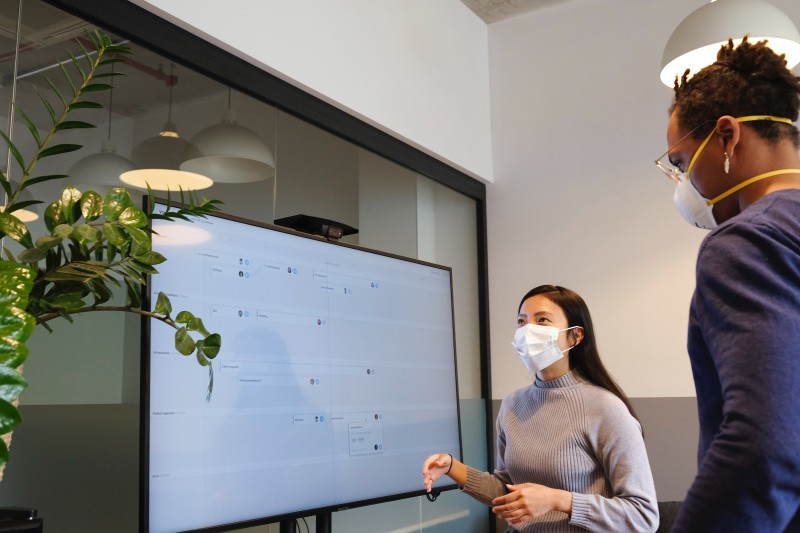
Product management is a challenging, rewarding, and ever-changing role to be in.
It can also be a lot of fun.
On any given day, a Product Manager may be tasked with market research, product strategy, communicating ideas, coordinating product development, gathering feedback from users, analyzing data, defining and prioritizing product iterations, and creating product roadmaps.
… if you’re tired just by reading that list, maybe jumping ship is better now.
Because, the long and short of it is if you want to become a product manager, you need to be prepared to learn and excel at a great number of things.
To become a Jack of all trades, master of...all, so to speak.
But this is actually good news for those looking to break into the world of product management.
Why?
Well, seeing as successful PMs possess such a broad collection of skills and strengths, there’s no ‘one size fits all’ way to landing that first internship — or full-time job — in product management. The doors can be open for anyone, from any walk of life, if they show the right potential.
And the backgrounds from which PMs typically come are as diverse as the role itself.
Some will have transitioned from engineering, others from marketing, some from project management, and so on.
For those going into the field without much professional experience, qualifications in subjects such as computer science, data science, business, marketing (and more) will come in handy.
What’s more, PM opportunities are popping up at organizations across all sectors these days. Sure, the Silicon Valley firms — Facebook, Apple, Netflix, etc. — are sure to have big product teams.
But considering the current “There’s an app for that” culture, companies from finance to FMCG now have the need for Product Managers.
Essentially, where there’s a digital product to build or improve on — a website, app, online marketplace — a PM can help deliver it.
And while some companies may have a clear idea of the kind of skills or education they require a PM to have, others will offer internships to high-potential people without much relevant experience or qualifications at all.
It’s the latter we’re going to focus on in this how-to guide — keep reading for our tips and advice for landing a product manager internship (and securing a full-time PM job as a result).
First up, what is the value of a PM internship? (and what can you expect to learn?)
You could rush in and start applying for full-time PM jobs right away — and that’s an approach that’ll work for some people.
But for others — especially those looking to make a pretty radical career change into the product management sector — an internship is the perfect way to dip your toes in the water and take the PM role for a test drive.
By spending a few weeks or months immersed in a working product team, you’ll get a great insight into the DNA of the department, along with what would be expected of you as a fully-fledged PM.
It’s also an invaluable opportunity to get hands-on experience, build relationships, and maybe even demonstrate how valuable you would be on the team long term.
But before we start talking about actually landing that full-time role, let’s dive into some of the most valuable benefits of a PM internship in a bit more detail...
Collaboration

Great products are the outcome of a talented, cross-discipline team working together.
Product owners, designers, developers, project managers, sales, marketing — all these roles feed into product development in one way or another.
It’s the PM’s role to manage key stakeholders, hear their input, execute the actions required (and politely sideline anything that doesn’t feed into the overall strategy).
In short, collaboration is a major part of a Product Managers day-to-day role — in a way that’s hard to understand unless you really see it for yourself.
Customer conversations
Any Product Manager worth their salt understands — and appreciates — the power of user-centric design.
And you won’t get very far with a product without hearing from the customer themselves.

This can be a crucial learning curve for those new to the product management role. But once you see how often the team refers back to user ‘jobs to be done’, buyer personas, or undergoes usability testing, you’ll quickly see how prevalent the customer's voice is in day-to-day development — and for good reason.
Developing a product
No product can be developed to solve a particular problem without a thorough understanding of the customers’ common challenges. And not only that, but once a product is being developed, speaking with customers is the best way to get feedback about which features and functionalities meet their needs, and which don’t.
Interviewing customers effectively means asking great questions, as well as knowing which answers and feedback carry the most weight. A core element of the customer interview skillset is being able to decipher feedback. As a result, PM’s can determine which product changes to prioritize to deliver the most amount of value.
Seeing this in action when shadowing a PM for example, can be a memorable lesson in user-centric development 101.
Prioritization
Deciding which improvements and iterations to prioritize — based on customer feedback, market changes and the company’s ongoing goals and objectives — is somewhat of a minefield, and takes real hands-on experience to get to grips with.
Shadowing and observing experienced product managers is invaluable for learning this process.
And when it comes to working out which customers to focus on (for gathering that crucial feedback), that cross-team network will come in handy (again).
Those teams who are closest to customers, such as sales and customer support, will be extremely valuable for advising you on which customers to request interviews with. They may have already received some vital customer feedback, so checking in with those teams regularly will reap many rewards.

What should you expect to do on a PM internship?
Your day-to-day responsibilities as a product manager intern will vary significantly. Although you won’t have much in the way of authority and decision-making power, you will have a voice and your opinions will still count.
The majority of PM internships begin with a comprehensive run-through of the product and its lifecycle, how it works, and what the product vision and roadmap look like. Then, you’ll get to experience...
Product backlogs
You can think of the product backlog as a development to-do list, organized in priority order.
It’s a dynamic document, changing in response to external and internal factors (including that much-needed customer insight). As such, PMs rely heavily on the content of this backlog to strategically plan what needs doing and when.
During your internship, you’ll likely get to interact with a real-life product backlog — helping the PM or other team members keep it up to date, aligning actions with the strategic roadmap, and reprioritizing when needed.
Product roadmaps
Your PM internship will also see you contributing to product roadmaps — high-level visual summaries that help communicate the direction of a product and its strategic plan.

In almost all cases, the roadmap will have already been developed before you begin your internship.
That said, as with the product backlog, the roadmap is constantly evolving. As an intern on the product management team, you’ll be involved in making recommendations for improvements to the roadmap, as well as organizing next steps.
Product strategies
Useful conversations
If you really want to impress during your internship, you should look to have useful conversations with other department workers (not just watercooler chat, although that’s important, too). You’ll also want to take time to analyze user data and feedback from customers.
Why does this matter?
Because, when done right, this insight puts you in a strong position to offer informed and considered contributions to product and business strategies — yes, you, the intern!
As a valued member of the team, you’ll then be invited to play your part by suggesting new initiatives, or by recommending how to improve existing strategies.
Ultimately these responsibilities lie with the Product Manager. So as an intern, this gives you a great opportunity to prove your worth and show the team how resourceful you are, and how much value your contributions add.
Okay, so now you know why you’d want a PM internship — how do you go about getting one?
Whether you’re approaching product management from a different profession, or as someone not long out of college or university, landing an internship with no professional PM-related experience can seem pretty tough.
Standing out from the crowd is crucial and here some ways you can do that.
Develop technical foundations
Certain PM roles (even at intern level) will require you to have specific technical know-how. It might be working knowledge of certain software — Jiro, Wrike, etc. Or even a basic understanding of HTML and CSS.
But even when it’s not a formal requirement, it’s still a huge advantage for you to know and understand what’s involved in developing products at a technical level.
Technical foundation
Technical foundations will help you communicate with developers and project managers — establishing credibility quickly with the people responsible for building the product (and maybe even making the hires!).
Sharpen your technical skills and you’ll reinforce your chances of landing a great PM internship.
Demonstrate initiative and entrepreneurship
What relevant initiatives and projects have you been involved in already — in your current or previous job, as a side hustle, or during your studies?
While it might not be essential to have built or launched something yourself, you’ll be a much stronger candidate if you've had some exposure to product development. The ability to analyze market trends, identify related problems, and create solutions is at the essence of product management.
If you can demonstrate the valuable entrepreneurial skills that make a great PM, you will grab the attention of any established company that is looking for a PM intern (and maybe some companies that aren’t).
Proactively seek opportunities

Applying formally for open positions can work, and when you see something that looks good on any job boards or relevant websites, you should definitely go for it. If the company where you work now has a product team, then that would also be an obvious first avenue to explore.
But your search for the right PM internship shouldn't end there, and getting your foot in the door at another company will often not happen as a result of a standard application.
Cold emails or LinkedIn messages — as uncomfortable as they may feel — are a great way to begin a conversation, even if there are currently no opportunities for internships at that company.
Do your research about the firm and the person you’re reaching out to. In that initial message explain concisely why you’re contacting them and why you want to intern there, as well as what skills and experience you have that would make you a great member of the product management team.
Don’t give up
If you hear back, see if they’d be open to a call. If you don't hear back, follow up a few days later. If you do receive a response and it's a 'no', keep in touch with them. (You never know what might come up in the future.) If you never hear back, try somebody else at that company.
As with any first moves towards a new career, you will receive knock-backs. But that's fine. You will need to keep trying — think of it as a development project in itself, learn as you go and make improvements to your approach.
Once you get your foot in the door, here’s how to take your first full-time steps inside...
So by now, you’ve worked tirelessly at finding a PM internship role and you’ve landed one — nice work!
After all that preparation, it would be a shame not to see this first exposure lead somewhere really great. Here are some ways you can make the most of a PM internship to give yourself the best chance of landing a FT role...
Demonstrate leadership skills
Being an effective leader and having the ability to inspire and motivate others is an essential attribute of a PM. Take every opportunity you can during your internship to practice your leadership skills.

Leading in groups (either product-related or not) requires a lot of different qualities and skills: initiative, communication, diplomacy, decisiveness, vision.
Get involved with any initiatives within the company (or start your own project), and put yourself forward for leadership positions whenever you can.
Demonstrating leadership skills during your internship will also help to show that you can work with other people effectively, which, again, is another crucial element of the role of a successful PM.
Communication is key
Being a product manager means listening to customers and internal stakeholders, interpreting this information before communicating it clearly and concisely to other teams.
PMs need to be able to talk with conviction and influence. They need to be able to sell their vision and to be extremely effective at communicating and advocating for new ideas and concepts.
Many leadership teams look for great communicators in the product management team. And what better way to showcase your skills than when you’re collaborating with other teams during your internship?
Network, network, network
You need to be proactive at building your network. This will mean going out of your way to meet members of other teams, to establish connections, and to develop those relationships.
During your internship, you'll be in a great position to build your network on the inside of a company — collaborating regularly with other product workers. But you're not limited to making friends there.
Reach out to people in other relevant roles and even other companies to introduce yourself. Make friends with people who are further along the path you want to go down. Make friends with people at companies where you would like to work. Make friends wherever you can, really.
Whether your PM internship turns into a full-time position at that same company or strengthens your approach to others, it will have been extremely valuable for beginning your new career and you will be in a much stronger position coming out of it than you were going in.
Feeling ready to take on the world of product management? airfocus can help you out
At airfocus, we like to think of ourselves as the product manager’s best friend — our prioritization, roadmapping, and collaboration tools make managing people and products so much easier (and more effective, too).
What’s more, we’ve built out an entire online glossary, demystifying the (often confusing) terminology and jargon spoken in product teams across the world.
Ready to start walking the walk and talking the talk as a product manager? You can start right here.

Malte Scholz

Read also





Experience the new way of doing product management

Experience the new way of doing product management



